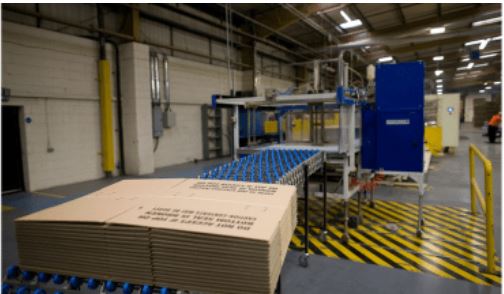Packaging professionals love to talk about their products, but more so than the substrates used in cardboard, tape, polyethene and stretch film.
How a cardboard box is made in Custom Printing Services.
Cardboard boxes are certainly one of the staples of the packaging industry. But it’s easy to forget that the cardboard boxes you use regularly were once a less humble tree.
How is wooden corrugated cardboard made? Well, the wait is over! Custom Printing Services asked their technologists to tell us exactly how the raw materials are cleaned and processed to make the cartons you buy every day for your business.
Why not? You can add these facts to the general knowledge in your brain, which is for quizzes and demos in pubs.
First the basics,
A cardboard box essentially consists of a groove (made from recycled paper) that is inserted between two liners. It is very common these days that these liners also make up a significant amount of recycled content made from old cartons or other sources of waste paper.
However, clean energy is still used to produce high-quality cardboard boxes. It doesn’t matter if the paper is recycled or not, however, in the end, it always started as white paper made from shredded trees.
The trees
When making cardboard boxes, we are talking about two different types of films.
Corrugated cardboard consists of the material located above and below the corrugation. Cardboard boxes usually have a pulp paper inner lining and kraft outer liner. This is because kraft paper is of better quality than proofing paper and has a smoother surface, making it easier to print. Kraft also has the advantage of being more resistant to water ingress, which is an added benefit of outdoor use.
To achieve this smoothness, kraft paper should be made from softwoods, which tend to have long fibers such as pine, spruce, and fir trees. Most of the European paper is produced from trees from sustainable forests owned by SCA (Svenska Cellulosa Aktiebolaget – English: Swedish Pulp Company), which plants two trees for every tree felled. Long fibers also have better tension, which is why kraft paper is often described as being very resistant to tearing and cracking.
The appearance of kraft paper can vary depending on the type of wood. For example, kraft paper made from Scandinavian fir, pine and silver birch is dark brown in colour, but Russian versions of the same wood species appear brown and darker spots of brighter colours. … In Brazil, eucalyptus and fir are used and the potency they produce is light brown, while Chinese trees are yellowish due to the high straw content in their potency.
Test paper inserts are generally made from short-barreled hardwoods or recycled paper, so they are cheaper and of more abrasive quality. Hardwoods include oak, sycamore, birch and chestnut, and again mostly from sustainable SCA forests. Kraft paper and pulp paper are also used to create corrugated paper between the inserts, which ultimately creates a stable sheet.
A brief guide to cardboard boxes by Custom Packaging Services.
